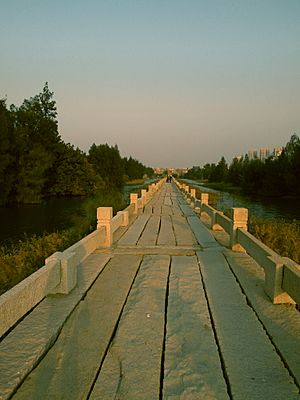Martín de Rada facts for kids
Martín de Rada (born June 30, 1533, in Pamplona, Navarre, Spain – died June 12, 1578, in the South China Sea) was an important Spanish missionary. He was one of the first members of the Order of Saint Augustine (called Augustinians) to bring Christianity to the Philippines. He was also one of the first Christian missionaries to visit Ming China.
Early Life and Studies
When Martín de Rada was twelve years old, his parents sent him and his older brother to study at the University of Paris. However, due to conflicts, he had to return to Spain. He then joined the University of Salamanca, where he became an Augustinian monk on November 21, 1554.
In 1560, while working at an Augustinian monastery in Toledo, he decided to volunteer for missionary work in New Spain (which is now Mexico). Alonso de la Vera Cruz, an Augustinian educator who founded the first university in the New World (the Americas) in Mexico, described de Rada as "a man of uncommon talent, a good theologian and an expert in mathematics."
In Mexico, de Rada was asked to learn the Otomi language. He became fluent in it in just five months! He then wrote sermons and a book in that language. His skills and leadership abilities were noticed by his Augustinian leaders in both Mexico and Spain.
Journey to the Philippines
In 1564, Augustinians were chosen to go with Andrés de Urdaneta, another Augustinian, on a royal trip to the Philippines. This trip was led by Don Miguel López de Legazpi and sailed from Mexico. De Rada's religious superior in Spain wanted him to stay in Mexico until they knew if Legazpi's fleet had successfully reached and settled the Philippines.
But de Rada had already sailed with the Legazpi expedition before his superior's letter arrived in Mexico. The expedition reached Cebu in the Philippines on April 27, 1565.
On June 1, 1565, Urdaneta and Andrés de Aguirre began their famous return trip to Mexico. De Rada stayed in the Philippines with Diego de Herrera and Pedro de Gamboa. These three quickly learned the local Cebuano language.
De Rada stayed in Cebu from 1565 to 1572. Because of his work there, he is known as "the apostle of the Christian Faith in Cebu." In 1566-67, he also traveled to nearby islands, especially Panay, and preached there. In 1572, he became the main Augustinian leader in the Philippines.
While in Cebu, de Rada started to study Chinese. In 1574, he helped as an interpreter for a group of Chinese merchants who visited Manila. Later, he suggested a plan for Spain to expand its influence in China, but this plan was never carried out.
Important Contributions
On June 26, 1575, de Rada and Jeronimo Marin, another Augustinian, joined a group of officials on a trip to China. They arrived at the port of Amoy (now Xiamen) in Hokkien province on July 5. They visited several cities and returned to Manila on October 28, 1575.
De Rada wrote detailed notes about the Chinese people and their way of life. In 1578, the governor of Manila sent de Rada on another trip, this time to Borneo. There was a disagreement within the sultan's family there.
The expedition left Manila on March 3, 1578, but it was not successful. On the way back, many people on the trip became sick. De Rada was one of them. He died at sea on June 12, just before the ship reached Manila. He was only forty-five years old.
Martín de Rada is well-remembered as a strong defender of the Filipino people. He spoke out against unfair actions by Spanish officials. An important document he wrote about this was called Parescer del Provincial fray Martin de Rada, agostino, sobre las coasa de estas tieras (which means "About the abuses committed against the natives in the collection of tributes"). He wrote this in Manila on June 21, 1574.
See also
 In Spanish: Martín de Rada para niños
In Spanish: Martín de Rada para niños
- Gaspar da Cruz, a Dominican missionary who visited China before de Rada.
- Juan González de Mendoza, whose book (1585) used much of de Rada's information about his trip to China.
- Boxer Codex (1590), a book also based on materials de Rada brought from China.



